fertility and family planning trends in urban nigeria: a research brief
fertility and family planning trends in urban nigeria: a research brief
fertility and family planning trends in urban nigeria: a research brief
Create successful ePaper yourself
Turn your PDF publications into a flip-book with our unique Google optimized e-Paper software.
Your Resource for Urban Reproductive Health<br />
FERTILITY AND FAMILY PLANNING TRENDS IN URBAN<br />
NIGERIA: A RESEARCH BRIEF<br />
BACKGROUND<br />
Rapid <strong>urban</strong>ization <strong>in</strong> Nigeria is putt<strong>in</strong>g pressure on<br />
<strong>in</strong>frastructure <strong>and</strong> erod<strong>in</strong>g the quality of life.<br />
NURHI is implement<strong>in</strong>g <strong>in</strong>terventions <strong>in</strong> four cities across<br />
Nigeria, <strong>in</strong>clud<strong>in</strong>g <strong>in</strong> Kaduna—one of the largest cities <strong>in</strong><br />
northern Nigeria.<br />
Key F<strong>in</strong>d<strong>in</strong>gs<br />
• Urban <strong>fertility</strong> rema<strong>in</strong>s high <strong>in</strong> Nigeria, with<br />
women bear<strong>in</strong>g an average of 4.7 children, due<br />
<strong>in</strong> part to early childbear<strong>in</strong>g <strong>and</strong> short birth<br />
<strong>in</strong>tervals.<br />
• Modern contraceptive use is low among<br />
<strong>urban</strong> women, especially among the poor <strong>and</strong><br />
uneducated.<br />
• A large proportion of the <strong>urban</strong> population is<br />
young, result<strong>in</strong>g from <strong>and</strong> contribut<strong>in</strong>g to high<br />
<strong>fertility</strong>.<br />
• Gaps <strong>in</strong> <strong>fertility</strong> levels <strong>and</strong> contraceptive use<br />
between the rich <strong>and</strong> poor, <strong>and</strong> the most <strong>and</strong><br />
least educated, are grow<strong>in</strong>g.<br />
• Men want large families, <strong>and</strong> many do not talk<br />
to their wives about <strong>family</strong> <strong>plann<strong>in</strong>g</strong>.<br />
• The mass media have limited reach among some<br />
key audiences, such as poor <strong>urban</strong> women.<br />
• Women <strong>in</strong>creas<strong>in</strong>gly rely on the private sector<br />
for modern contraceptives.<br />
• Sharp regional differences <strong>in</strong> <strong>fertility</strong> levels <strong>and</strong><br />
<strong>family</strong> <strong>plann<strong>in</strong>g</strong> attitudes <strong>and</strong> practices persist.<br />
Nigeria’s <strong>urban</strong> population grew from about 7 million<br />
<strong>in</strong> 1960 to nearly 79 million <strong>in</strong> 2010. Half of all<br />
Nigerians were liv<strong>in</strong>g <strong>in</strong> cities by 2010, <strong>and</strong> that<br />
proportion is projected to grow to three-quarters by<br />
2050. 1 Urban <strong>plann<strong>in</strong>g</strong> <strong>and</strong> <strong>in</strong>frastructure have not kept<br />
pace with this rapid growth, leav<strong>in</strong>g many city dwellers<br />
without adequate hous<strong>in</strong>g, sanitation, safe water or<br />
other services. In 2005, an estimated two-thirds of<br />
Nigeria’s <strong>urban</strong> population lived <strong>in</strong> slums. 2<br />
The Nigeria Urban Reproductive Health Initiative<br />
(NURHI) seeks to <strong>in</strong>crease use of modern<br />
contraceptives by the <strong>urban</strong> poor.<br />
NURHI’s objective is to <strong>in</strong>crease significantly the<br />
contraceptive prevalence rate over five years <strong>in</strong> four<br />
cities across Nigeria. To achieve this, NURHI is<br />
design<strong>in</strong>g <strong>and</strong> implement<strong>in</strong>g <strong>in</strong>terventions to:<br />
• Integrate <strong>family</strong> <strong>plann<strong>in</strong>g</strong> with other health services;<br />
• Improve the quality of <strong>family</strong> <strong>plann<strong>in</strong>g</strong> services for<br />
the <strong>urban</strong> poor;<br />
• Partner with the private sector;<br />
• Generate dem<strong>and</strong> for contraceptives among<br />
marg<strong>in</strong>alized <strong>urban</strong> populations; <strong>and</strong><br />
• Improve fund<strong>in</strong>g <strong>and</strong> the policy environment.<br />
A reanalysis of Demographic <strong>and</strong> Health Survey data<br />
sheds light on <strong>fertility</strong> <strong>and</strong> <strong>family</strong> <strong>plann<strong>in</strong>g</strong> <strong>trends</strong><br />
among the <strong>urban</strong> poor.<br />
To exp<strong>and</strong> the knowledge base on <strong>urban</strong> reproductive<br />
health <strong>and</strong> help NURHI design effective <strong>in</strong>terventions<br />
for Nigeria, the Measurement, Learn<strong>in</strong>g & Evaluation<br />
(MLE) Project undertook a secondary analysis of <strong>urban</strong><br />
1<br />
United Nations Department of Economic <strong>and</strong> Social Affairs, World<br />
Urbanization Prospects: The 2009 Revision, http://esa.un.org/unpd/wup/<br />
<strong>in</strong>dex.htm, accessed 6/29/2011.<br />
2<br />
Population Reference Bureau, DataF<strong>in</strong>der, http://www.prb.org/DataF<strong>in</strong>der.<br />
aspx, accessed 6/29/2011.<br />
MLE Research Brief 1-2011<br />
www.<strong>urban</strong>reproductivehealth.org<br />
1
data from the 1990, 1999 3 , 2003 <strong>and</strong> 2008 rounds of<br />
the Nigeria Demographic <strong>and</strong> Health Survey (NDHS). 4<br />
Data from <strong>urban</strong> survey respondents were recoded<br />
<strong>and</strong> reanalyzed to describe levels <strong>and</strong> <strong>trends</strong> <strong>in</strong> key<br />
<strong>fertility</strong>, <strong>family</strong> <strong>plann<strong>in</strong>g</strong> <strong>and</strong> reproductive health<br />
<strong>in</strong>dicators. The analysis also exam<strong>in</strong>es differentials<br />
by region, household wealth <strong>and</strong> education, although<br />
these variables are <strong>in</strong>ter-related. There is considerable<br />
overlap between the wealthy <strong>and</strong> better educated<br />
groups.<br />
Figure 1. TFR <strong>in</strong> <strong>urban</strong> areas, by region, 2008<br />
TFR <strong>in</strong> <strong>urban</strong> areas, by region, 2008 NDHS<br />
South West<br />
South South<br />
South East<br />
North West<br />
North East<br />
North Central<br />
All <strong>urban</strong> areas<br />
0 1 2 3 4 5 6 7 8<br />
TFR<br />
A large proportion of the <strong>urban</strong> population is young.<br />
Over 40 percent of the <strong>urban</strong> population <strong>in</strong> Nigeria is<br />
less than 15 years old, while only 4 percent is aged<br />
65 or older. This young population structure results<br />
from <strong>and</strong> contributes to cont<strong>in</strong>ued high <strong>fertility</strong>. The<br />
high ratio of dependents to workers stra<strong>in</strong>s the ability<br />
of cities to meet residents’ essential needs, <strong>in</strong>clud<strong>in</strong>g<br />
health, education, food <strong>and</strong> shelter.<br />
There is a widen<strong>in</strong>g gap between the rich <strong>and</strong> poor,<br />
<strong>and</strong> the more <strong>and</strong> less educated.<br />
In Ibadan, Nigeria, young people comprise a large<br />
proportion of the city’s population.<br />
HOW HIGH IS FERTILITY IN NIGERIAN<br />
CITIES?<br />
Fertility rema<strong>in</strong>s high <strong>in</strong> <strong>urban</strong> Nigeria, especially <strong>in</strong><br />
the north.<br />
Over the past two decades, <strong>fertility</strong> levels have changed<br />
little, decl<strong>in</strong><strong>in</strong>g only from 5.1 children <strong>in</strong> 1990 to 4.7<br />
children <strong>in</strong> 2008. Women <strong>in</strong> the North East <strong>and</strong> North<br />
West have 2 more children, on average, than women <strong>in</strong><br />
other regions of the country (Figure 1).<br />
3<br />
Because the 1999 survey was collected with limited technical assistance<br />
from the DHS program, data from 1999 may not be directly comparable to<br />
data from other years.<br />
4<br />
This <strong>research</strong> <strong>brief</strong> summarizes <strong>family</strong> <strong>plann<strong>in</strong>g</strong> <strong>and</strong> <strong>fertility</strong> data from<br />
the MLE’s reanalysis of NDHS data. For the full paper, see Jean Christophe<br />
Fotso et al., “Family Plann<strong>in</strong>g <strong>and</strong> Reproductive Health <strong>in</strong> Urban Nigeria:<br />
Levels, Trends <strong>and</strong> Differentials,” MLE Technical Work<strong>in</strong>g Paper 2-2010<br />
(January 2011). http://www.<strong>urban</strong>reproductivehealth.org/system/files/<br />
F<strong>in</strong>al%20<strong>nigeria</strong>%20twp%201-27-11.pdf<br />
TFR<br />
The burden of high <strong>fertility</strong> <strong>and</strong> its associated health<br />
risks falls more heavily on the poor <strong>and</strong> less educated.<br />
From 1990 to 2008, <strong>fertility</strong> rose <strong>in</strong> poor <strong>urban</strong><br />
households by over 9 percent, while fall<strong>in</strong>g by about 10<br />
percent <strong>in</strong> rich <strong>and</strong> middle-<strong>in</strong>come households<br />
(Figure 2). 5 Trends by education followed a similar<br />
pattern. By 2008, the <strong>urban</strong> poor had 2.2 more children,<br />
on average, than the rich; women with no education<br />
had 3.1 more children than those with secondary or<br />
higher education.<br />
Figure 2. Trend <strong>in</strong> <strong>urban</strong> TFR, by household wealth<br />
Trend <strong>in</strong> <strong>urban</strong> TFR, by household wealth<br />
7<br />
6<br />
5<br />
4<br />
3<br />
2<br />
Poor Middle Rich<br />
1990 1999 2003 2008<br />
5<br />
The analysis divided the population <strong>in</strong>to three equal groups (or tertiles)<br />
by household wealth. All data on the <strong>urban</strong> poor describe the bottom tertile,<br />
while data on the rich describe the top tertile.<br />
MLE Research Brief 1-2011 2<br />
www.<strong>urban</strong>reproductivehealth.org
Early childbear<strong>in</strong>g, particularly among the <strong>urban</strong><br />
poor, <strong>and</strong> short birth <strong>in</strong>tervals contribute to high<br />
<strong>fertility</strong>.<br />
Adolescent childbear<strong>in</strong>g <strong>and</strong> short birth <strong>in</strong>tervals<br />
<strong>in</strong>crease health risks for mothers <strong>and</strong> children. The<br />
proportion of <strong>urban</strong> teenagers who were pregnant or<br />
mothers decl<strong>in</strong>ed from 17.4 percent <strong>in</strong> 1990 to 12.0<br />
percent <strong>in</strong> 2008, but teen pregnancy rates rema<strong>in</strong> high<br />
among the poor <strong>and</strong> uneducated (Figure 3). In 2008,<br />
23% of poor <strong>urban</strong> teenagers were pregnant or mothers<br />
compared with 4% of rich <strong>urban</strong> teenagers. Teenagers<br />
with no education are 7.8 times more likely to become<br />
mothers than those with secondary or higher education.<br />
Figure 3. Percent of <strong>urban</strong> teenagers who were<br />
Percent of <strong>urban</strong> teenagers who were<br />
pregnant or mothers, by wealth <strong>and</strong> education<br />
Percent<br />
60<br />
50<br />
40<br />
30<br />
20<br />
10<br />
0<br />
Poor<br />
pregnant or mothers, by wealth <strong>and</strong> education<br />
Middle<br />
Rich<br />
1990 2008<br />
No education<br />
Primary<br />
Secondary<br />
HOW COMMON IS USE OF MODERN<br />
CONTRACEPTIVE METHODS?<br />
Modern contraceptive use is especially low among poor<br />
<strong>and</strong> uneducated women <strong>and</strong> <strong>in</strong> parts of the north.<br />
Overall, modern contraceptive use 6 rose from 9.6<br />
percent of <strong>urban</strong> women <strong>in</strong> 1990 to 16.7 percent <strong>in</strong><br />
2008. However, ga<strong>in</strong>s were much smaller among poor<br />
households (Figure 4) <strong>and</strong> women with no education.<br />
Only 7 percent of poor women <strong>and</strong> 5 percent of<br />
uneducated women used a modern method <strong>in</strong> 2008.<br />
Rich women are 3.5 times more likely to use a modern<br />
method than poor women.<br />
Percent of <strong>urban</strong> women currently us<strong>in</strong>g modern<br />
contraception, by household wealth<br />
Less than 7 percent of women <strong>in</strong> the North East<br />
<strong>and</strong> North West use modern contraception. Women<br />
elsewhere are two to four times more likely to use a<br />
modern method.<br />
Figure 4. Percent of <strong>urban</strong> women currently us<strong>in</strong>g<br />
modern contraception, by household wealth<br />
In Ilor<strong>in</strong>, Nigeria, young mothers <strong>and</strong> their babies wait to<br />
receive health services.<br />
Percent<br />
30<br />
25<br />
20<br />
15<br />
10<br />
5<br />
0<br />
Poor Middle Rich<br />
1990 1999 2003 2008<br />
Almost one <strong>in</strong> four births <strong>in</strong> Nigerian cities is preceded<br />
by a short birth <strong>in</strong>terval (less than two years), <strong>and</strong> there<br />
has been little change over the past two decades.<br />
6<br />
In all four surveys, modern contraceptives <strong>in</strong>cluded the follow<strong>in</strong>g methods:<br />
female <strong>and</strong> male sterilization, oral contraceptive pills, <strong>in</strong>trauter<strong>in</strong>e devices<br />
(IUDs), <strong>in</strong>jectables, implants, male condoms, diaphragms, foam <strong>and</strong> jelly.<br />
The 2003 <strong>and</strong> 2008 surveys added three additional modern methods:<br />
female condoms, Lactational Amenorrhea Method (LAM) <strong>and</strong> emergency<br />
contraception.<br />
MLE Research Brief 1-2011<br />
www.<strong>urban</strong>reproductivehealth.org<br />
3
Urban women <strong>in</strong>creas<strong>in</strong>gly use contraceptive methods<br />
to space births.<br />
The percentage of married <strong>urban</strong> women who adopt<br />
contraception when they have just one or two children<br />
doubled from 1990 to 2008 (Figure 5), which suggests<br />
that they are us<strong>in</strong>g contraception to space births.<br />
Because couples want large families, few births are<br />
considered mistimed or unwanted. In 2008, <strong>urban</strong><br />
women reported that 4.9 percent of births <strong>in</strong> the<br />
preced<strong>in</strong>g five years were not wanted, while 6.8<br />
percent were mistimed. As a result, there is little<br />
perceived need for <strong>family</strong> <strong>plann<strong>in</strong>g</strong>.<br />
Women Percent are two distribution to four of times currently more married likely <strong>urban</strong> to adopt<br />
contraceptive<br />
women by<br />
methods<br />
parity at first<br />
at lower<br />
contraceptive<br />
parities<br />
use<br />
if they come<br />
from rich rather than poor households, have secondary<br />
or higher education rather than no education or live <strong>in</strong><br />
the south rather than the north.<br />
Figure 5. Percent distribution of currently married<br />
<strong>urban</strong> women, by parity at first contraceptive use<br />
No children 1-2 children 3+ children<br />
Percent<br />
25<br />
20<br />
15<br />
10<br />
5<br />
0<br />
1990 1999 2003 2008<br />
WHAT ARE CURRENT ATTITUDES<br />
TOWARD FERTILITY AND FAMILY<br />
PLANNING?<br />
Urban women <strong>and</strong> men, especially the poor <strong>and</strong> less<br />
educated, still want large families.<br />
In 2008, <strong>urban</strong> women preferred to have 5.2 children,<br />
on average, while men preferred 5.8 children. This is<br />
Ideal number of children for <strong>urban</strong> women <strong>and</strong><br />
a decrease men, from by household 6.0 <strong>and</strong> 6.6 wealth, children, 2008 NDHS respectively, <strong>in</strong><br />
2003. Desired <strong>family</strong> size decreases with wealth <strong>and</strong><br />
education. Poor <strong>urban</strong> women <strong>and</strong> men want 2.3 <strong>and</strong><br />
3.9 more children, respectively, than the rich (Figure 6).<br />
Number<br />
Figure 6. Ideal number of children for <strong>urban</strong> women<br />
<strong>and</strong> men, by household wealth, 2008<br />
10<br />
8<br />
6<br />
4<br />
2<br />
0<br />
Women<br />
Men<br />
Poor Middle Rich<br />
A service provider counsels a client about reproductive<br />
health issues<br />
Less than two-fifths of the <strong>urban</strong> poor approve of<br />
us<strong>in</strong>g contraceptive methods.<br />
Widespread disapproval of <strong>family</strong> <strong>plann<strong>in</strong>g</strong> can act<br />
as a barrier to contraceptive use. The percentage<br />
of <strong>urban</strong> residents who approve of couples us<strong>in</strong>g<br />
contraception has been decl<strong>in</strong><strong>in</strong>g <strong>in</strong> Nigeria: from<br />
77.5 percent <strong>in</strong> 1990 to 60.3 percent <strong>in</strong> 2003 among<br />
women, <strong>and</strong> from 66.9 percent <strong>in</strong> 1999 to 58.1<br />
percent <strong>in</strong> 2003 Percent among of <strong>urban</strong> men. women 7 The <strong>urban</strong> <strong>and</strong> men rich who were<br />
twice as likely to approve of contraceptive of use, use as the<br />
poor <strong>in</strong> 2003, by the household last year for wealth, which 2003 there NDHS is DHS<br />
data (Figure 7). Differentials were even greater by<br />
education <strong>and</strong> region.<br />
Percent<br />
Figure 7. Percent of <strong>urban</strong> women <strong>and</strong> men who<br />
approve of contraceptive use, by household wealth,<br />
2003<br />
100<br />
80<br />
60<br />
40<br />
20<br />
0<br />
Women<br />
Men<br />
Poor Middle Rich<br />
7<br />
The 2008 NDHS did not ask respondents whether they approved of<br />
us<strong>in</strong>g contraceptive methods, so the data from 2003 is the most recent<br />
available.<br />
MLE Research Brief 1-2011 4<br />
www.<strong>urban</strong>reproductivehealth.org
contraceptives from the private sector, by<br />
household wealth<br />
Many <strong>urban</strong> women, especially the poor <strong>and</strong><br />
uneducated, do not <strong>in</strong>tend to use contraceptives <strong>in</strong> the<br />
future.<br />
Among <strong>urban</strong> women who are not currently us<strong>in</strong>g<br />
a contraceptive method, the proportion who do not<br />
<strong>in</strong>tend to use contraception <strong>in</strong> the future rose from<br />
53.3 percent <strong>in</strong> 1990 to 60.5 percent <strong>in</strong> 2003, before<br />
decl<strong>in</strong><strong>in</strong>g to 46.8 percent <strong>in</strong> 2008. From half to twothirds<br />
of poor women, uneducated women, <strong>and</strong> women<br />
liv<strong>in</strong>g <strong>in</strong> the North East <strong>and</strong> North West do not <strong>in</strong>tend<br />
to use contraception <strong>in</strong> the future.<br />
WHERE DO WOMEN OBTAIN<br />
CONTRACEPTIVE SUPPLIES?<br />
Women, <strong>in</strong>clud<strong>in</strong>g the <strong>urban</strong> poor, <strong>in</strong>creas<strong>in</strong>gly rely<br />
on the private sector for modern contraceptives.<br />
The private sector has the potential to <strong>in</strong>crease<br />
coverage of reproductive health services, especially for<br />
women who cannot or choose not to access government<br />
services. The proportion of <strong>urban</strong> women obta<strong>in</strong><strong>in</strong>g<br />
modern contraceptives from the private sector,<br />
<strong>in</strong>clud<strong>in</strong>g private hospitals/cl<strong>in</strong>ics, pharmacies, patent<br />
medical stores, <strong>and</strong> doctors, rose from 45.5 percent<br />
<strong>in</strong> 1990 to 60.7 percent <strong>in</strong> 2008. Although privatesector<br />
sources are more important for middle-<strong>in</strong>come<br />
<strong>and</strong> rich women, over half of the <strong>urban</strong> poor obta<strong>in</strong><br />
contraceptives from the private sector (Figure 8).<br />
Percent<br />
Figure 8. Percent of <strong>urban</strong> women obta<strong>in</strong><strong>in</strong>g<br />
modern contraceptives from the private sector, by<br />
household wealth<br />
80<br />
70<br />
60<br />
50<br />
40<br />
30<br />
20<br />
10<br />
0<br />
Poor Middle Rich<br />
1990 1999 2003 2008<br />
Women<br />
Percent<br />
<strong>in</strong> the south<br />
of <strong>urban</strong><br />
are<br />
women<br />
twice as<br />
obta<strong>in</strong><strong>in</strong>g<br />
likely as<br />
modern<br />
those <strong>in</strong><br />
the north contraceptives to obta<strong>in</strong> modern from contraceptives the private sector from the<br />
private sector.<br />
Reliance on the private sector has <strong>in</strong>creased <strong>in</strong> every<br />
region s<strong>in</strong>ce 1990 (Figure 9). In 2008, about 6 or 7<br />
<strong>family</strong> <strong>plann<strong>in</strong>g</strong> users <strong>in</strong> 10 relied on the private sector<br />
for contraceptive supplies <strong>in</strong> the south, compared with<br />
just 3 or 4 <strong>family</strong> <strong>plann<strong>in</strong>g</strong> users <strong>in</strong> 10 <strong>in</strong> the north.<br />
Figure 9. Percent of <strong>urban</strong> women obta<strong>in</strong><strong>in</strong>g<br />
modern contraceptives from the private sector<br />
1990<br />
2008<br />
South West<br />
South South<br />
South East<br />
North West<br />
North East<br />
North Central<br />
0 10 20 30 40 50 60 70 80<br />
Percent<br />
A <strong>family</strong> <strong>plann<strong>in</strong>g</strong> poster <strong>in</strong> a health care facility <strong>in</strong> the<br />
city of Kaduna illustrates the need for new communication<br />
strategies.<br />
MLE Research Brief 1-2011<br />
www.<strong>urban</strong>reproductivehealth.org<br />
5
HOW WIDELY DO THE MASS<br />
MEDIA SPREAD FAMILY PLANNING<br />
MESSAGES?<br />
Radio <strong>and</strong> television are the two most common<br />
media sources of <strong>family</strong> <strong>plann<strong>in</strong>g</strong> messages.<br />
The mass media are a powerful way to convey <strong>family</strong><br />
<strong>plann<strong>in</strong>g</strong> messages to the public <strong>and</strong> can help change<br />
social norms <strong>and</strong> facilitate behavior change. While<br />
radio ownership has rema<strong>in</strong>ed stable at about fourfifths<br />
of <strong>urban</strong> households, television ownership grew<br />
from 57.1 percent <strong>in</strong> 1990 to 69.0 percent <strong>in</strong> 2008.<br />
Televisions are primarily located <strong>in</strong> the south; radios<br />
have even geographic distribution.<br />
Radio <strong>and</strong> television are the most common media<br />
sources of <strong>family</strong> <strong>plann<strong>in</strong>g</strong> messages for <strong>urban</strong><br />
residents <strong>in</strong> Nigeria, regardless of sex, age, education,<br />
household wealth <strong>and</strong> region (see Figure 10 for data<br />
by sex).<br />
Percent<br />
Figure 10. Percent of <strong>urban</strong> women <strong>and</strong> men<br />
exposed to <strong>family</strong> <strong>plann<strong>in</strong>g</strong> messages <strong>in</strong> the mass<br />
media, 2008<br />
80<br />
70<br />
60<br />
50<br />
40<br />
30<br />
20<br />
10<br />
0<br />
Women<br />
Men<br />
Radio Television Newspapers None of these<br />
Men have greater exposure to the mass media than<br />
women.<br />
Men are more likely than women to have heard or<br />
seen a <strong>family</strong> <strong>plann<strong>in</strong>g</strong> message on radio, television<br />
<strong>and</strong> newspapers (Figure 10). Women are 1.5 times<br />
more likely than men to have no exposure at all to<br />
<strong>family</strong> <strong>plann<strong>in</strong>g</strong> messages <strong>in</strong> any of these media.<br />
Exposure to mass media <strong>in</strong>creases with wealth <strong>and</strong><br />
education.<br />
Percent of <strong>urban</strong> women exposed to <strong>family</strong><br />
Rich <strong>urban</strong> plannn<strong>in</strong>g women messages are more <strong>in</strong> likely the mass than media, the poor by<br />
to have heard household or seen <strong>family</strong> wealth, <strong>plann<strong>in</strong>g</strong> 2008 NDHS messages<br />
on radio, television <strong>and</strong> newspapers (Figure 11).<br />
Exposure to <strong>family</strong> <strong>plann<strong>in</strong>g</strong> messages <strong>in</strong> the mass<br />
media also <strong>in</strong>creases with education. Radio reached<br />
2.4 times as many poor households as television <strong>and</strong><br />
7.8 times as many households as newspapers <strong>in</strong> 2008.<br />
Figure 11. Percent of <strong>urban</strong> women exposed to<br />
<strong>family</strong> plannn<strong>in</strong>g messages <strong>in</strong> the mass media, by<br />
household wealth, 2008<br />
80<br />
Poor Middle Rich<br />
The new “Get it Together” <strong>family</strong> <strong>plann<strong>in</strong>g</strong> campaign<br />
from NURHI encourages people to get <strong>in</strong>formation,<br />
have conversations, <strong>and</strong> get a method.<br />
Percent<br />
70<br />
60<br />
50<br />
40<br />
30<br />
20<br />
10<br />
0<br />
Radio Television Newspapers None of these<br />
MLE Research Brief 1-2011 6<br />
www.<strong>urban</strong>reproductivehealth.org
Most of the <strong>urban</strong> poor <strong>and</strong> most women who live <strong>in</strong><br />
northern cities are not exposed to <strong>family</strong> <strong>plann<strong>in</strong>g</strong><br />
messages <strong>in</strong> the mass media.<br />
In <strong>urban</strong> areas, almost two-thirds of poor women did<br />
not hear, see or read <strong>family</strong> <strong>plann<strong>in</strong>g</strong> messages <strong>in</strong><br />
any of the mass media (Figure 11). Similarly, most<br />
<strong>urban</strong> women <strong>in</strong> the north were not exposed to <strong>family</strong><br />
<strong>plann<strong>in</strong>g</strong> messages <strong>in</strong> any media (Figure 12).<br />
Figure Percent 12. Percent of <strong>urban</strong> of women <strong>urban</strong> who women were who NOT were exposed NOT<br />
exposed<br />
to any <strong>family</strong> <strong>plann<strong>in</strong>g</strong><br />
<strong>plann<strong>in</strong>g</strong><br />
messages<br />
messages<br />
<strong>in</strong><br />
<strong>in</strong><br />
radio,<br />
radio,<br />
television or newspapers, by region, 2008 NDHS<br />
television or newspapers, by region, 2008<br />
South West<br />
South South<br />
South East<br />
North West<br />
North East<br />
North Central<br />
0 10 20 30 40 50 60 70 80<br />
Percent<br />
HOW LIKELY ARE COUPLES TO<br />
DISCUSS FAMILY PLANNING?<br />
Discussion of <strong>family</strong> <strong>plann<strong>in</strong>g</strong> among <strong>urban</strong> couples<br />
decl<strong>in</strong>ed from 1990 to 2003, the period for which data<br />
are available.<br />
Couple communication about <strong>family</strong> <strong>plann<strong>in</strong>g</strong> is an<br />
important step on the path to adopt<strong>in</strong>g a contraceptive<br />
method. In <strong>urban</strong> areas, the proportion of married<br />
women who had discussed <strong>family</strong> <strong>plann<strong>in</strong>g</strong> with their<br />
husb<strong>and</strong>s <strong>in</strong> the past year rose from 49.5 percent <strong>in</strong><br />
1990 to 54.5 percent <strong>in</strong> 1999, but then decl<strong>in</strong>ed to 43.3<br />
percent <strong>in</strong> 2003, the last year for which there is DHS<br />
data.<br />
Less than 30 percent of married teenaged women<br />
<strong>in</strong> <strong>urban</strong> areas reported discuss<strong>in</strong>g <strong>family</strong> <strong>plann<strong>in</strong>g</strong><br />
with their husb<strong>and</strong>s <strong>in</strong> 2003, compared with about 45<br />
percent of older women.<br />
Percent of married <strong>urban</strong> women who discussed<br />
Figure <strong>family</strong> 13. Percent <strong>plann<strong>in</strong>g</strong> of with married their spouse <strong>urban</strong> <strong>in</strong> the women past year, who<br />
discussed <strong>family</strong> <strong>plann<strong>in</strong>g</strong> by household with wealth their spouse <strong>in</strong> the<br />
past year, by household wealth<br />
Percent<br />
70<br />
60<br />
50<br />
40<br />
30<br />
20<br />
10<br />
0<br />
Poor Middle Rich<br />
1990 1999 2003<br />
Couple communication regard<strong>in</strong>g <strong>family</strong> <strong>plann<strong>in</strong>g</strong> is<br />
more common <strong>in</strong> parts of the south.<br />
Married <strong>urban</strong> women were considerably more likely<br />
to discuss <strong>family</strong> <strong>plann<strong>in</strong>g</strong> with their husb<strong>and</strong>s <strong>in</strong> the<br />
South West <strong>and</strong> South South than <strong>in</strong> other regions<br />
(Figure 14).<br />
Figure <strong>family</strong> 14. <strong>plann<strong>in</strong>g</strong> Percent with of married their spouse, <strong>urban</strong> by region, women 2003 who<br />
discussed <strong>family</strong> <strong>plann<strong>in</strong>g</strong> NDHS with their spouse, by<br />
region, 2003<br />
South West<br />
South South<br />
South East<br />
North West<br />
North East<br />
North Central<br />
Percent of married <strong>urban</strong> women who discussed<br />
0 10 20 30 40 50 60 70<br />
Percent<br />
Poor, uneducated <strong>and</strong> teenaged women are less likely<br />
than others to discuss <strong>family</strong> <strong>plann<strong>in</strong>g</strong> with their<br />
husb<strong>and</strong>s.<br />
In 2003, only one <strong>in</strong> four poor or uneducated <strong>urban</strong><br />
women reported discuss<strong>in</strong>g <strong>family</strong> <strong>plann<strong>in</strong>g</strong> with<br />
their husb<strong>and</strong>s. More than twice as many rich women<br />
(Figure 13) <strong>and</strong> highly educated women had done so.<br />
MLE Research Brief 1-2011<br />
www.<strong>urban</strong>reproductivehealth.org<br />
7
SUMMARY<br />
Urban <strong>fertility</strong> rema<strong>in</strong>s high, due <strong>in</strong> part to early<br />
childbear<strong>in</strong>g <strong>and</strong> short birth <strong>in</strong>tervals.<br />
Fertility <strong>in</strong> <strong>urban</strong> Nigeria has decl<strong>in</strong>ed slightly s<strong>in</strong>ce<br />
1990, but women still bear an average of 4.7 children.<br />
Teen pregnancies rema<strong>in</strong> common among the poor <strong>and</strong><br />
uneducated, despite a drop <strong>in</strong> overall teen pregnancy<br />
rates. There has been little change <strong>in</strong> birth spac<strong>in</strong>g:<br />
almost one <strong>in</strong> four births follows an <strong>in</strong>terval of less<br />
than two years.<br />
Because desired <strong>family</strong> size is high, contraceptive use<br />
rema<strong>in</strong>s low.<br />
There has been a small rise <strong>in</strong> modern contraceptive<br />
use s<strong>in</strong>ce 1990, but less than 7 percent of poor <strong>and</strong><br />
uneducated women use a modern method. A traditional<br />
preference for large families is the lead<strong>in</strong>g reason<br />
women do not use contraception. Most poor <strong>and</strong><br />
uneducated women do not <strong>in</strong>tend to use contraception<br />
<strong>in</strong> the future. However, there is grow<strong>in</strong>g <strong>in</strong>terest <strong>in</strong><br />
us<strong>in</strong>g modern methods to space births among wealthy<br />
<strong>and</strong> more educated women.<br />
A large proportion of the <strong>urban</strong> population is young,<br />
result<strong>in</strong>g from <strong>and</strong> contribut<strong>in</strong>g to high <strong>fertility</strong>.<br />
Over 40 percent of the <strong>urban</strong> population <strong>in</strong> Nigeria is<br />
less than 15 years old, while only 4 percent is aged<br />
65 or older. The high ratio of dependents to workers<br />
stra<strong>in</strong>s the ability of cities to meet residents’ essential<br />
needs, <strong>in</strong>clud<strong>in</strong>g health, education, food <strong>and</strong> shelter.<br />
Gaps <strong>in</strong> <strong>fertility</strong> <strong>and</strong> contraceptive use between the<br />
rich <strong>and</strong> poor, <strong>and</strong> the most <strong>and</strong> least educated, are<br />
grow<strong>in</strong>g.<br />
Over the last two decades, wealthy <strong>and</strong> well educated<br />
city dwellers have become more supportive of <strong>family</strong><br />
<strong>plann<strong>in</strong>g</strong>, <strong>and</strong> their <strong>fertility</strong> rate has dropped. Trends<br />
have moved <strong>in</strong> the opposite direction for the <strong>urban</strong> poor<br />
<strong>and</strong> those with no education.<br />
Male <strong>in</strong>volvement <strong>in</strong> <strong>family</strong> <strong>plann<strong>in</strong>g</strong> is limited.<br />
Men are more likely than women to see or hear <strong>family</strong><br />
<strong>plann<strong>in</strong>g</strong> messages <strong>in</strong> the mass media. However, <strong>urban</strong><br />
men—especially poor men—want even larger families<br />
than women do. Most poor <strong>and</strong> uneducated couples<br />
have not discussed <strong>family</strong> <strong>plann<strong>in</strong>g</strong> <strong>in</strong> the past year.<br />
The mass media have limited reach among some key<br />
audiences.<br />
Radio is the most common media source of <strong>family</strong><br />
<strong>plann<strong>in</strong>g</strong> messages <strong>in</strong> <strong>urban</strong> Nigeria. However, it<br />
reaches less than two-fifths of poor <strong>urban</strong> women <strong>and</strong><br />
less than half of <strong>urban</strong> women <strong>in</strong> the north.<br />
Women, <strong>in</strong>clud<strong>in</strong>g the <strong>urban</strong> poor, <strong>in</strong>creas<strong>in</strong>gly rely<br />
on the private sector for modern contraceptives.<br />
Over the past two decades, the proportion of women<br />
who obta<strong>in</strong> modern contraceptives from the private<br />
sector has <strong>in</strong>creased <strong>in</strong> every region of the country.<br />
Today the majority of <strong>urban</strong> women—<strong>in</strong>clud<strong>in</strong>g poor<br />
women—rely on the private sector for contraceptive<br />
supplies.<br />
Sharp regional differences <strong>in</strong> attitudes <strong>and</strong> practices<br />
about <strong>family</strong> <strong>plann<strong>in</strong>g</strong> <strong>and</strong> contraceptive use persist.<br />
There is a substantial gap between north <strong>and</strong> south on<br />
most <strong>in</strong>dicators. Fertility rates are markedly higher<br />
<strong>in</strong> some areas of the north, while approval <strong>and</strong> use<br />
of <strong>family</strong> <strong>plann<strong>in</strong>g</strong> methods are lower. Women <strong>in</strong><br />
the north are also less likely to rely on private sector<br />
sources for modern contraceptives or to see or hear<br />
<strong>family</strong> <strong>plann<strong>in</strong>g</strong> messages <strong>in</strong> the mass media.<br />
For more detailed <strong>in</strong>formation about the NURHI study<br />
cities, see the “2010-2011 Nigeria Basel<strong>in</strong>e Survey for<br />
the Urban Reproductive Health Initiative” report at www.<br />
nurhi.org/sites/nurhi.k4health.org/files/2011_Nigeria_<br />
Urban_Reproductive_Health_Survey_FINAL.pdf.<br />
For more <strong>in</strong>formation about <strong>urban</strong> reproductive health, please visit www.<strong>urban</strong>reproductivehealth.org.<br />
This fact sheet was made possible by support from the Bill & Mel<strong>in</strong>da Gates Foundation under terms of the MLE project for the<br />
Urban Reproductive Health Initiative. The MLE project is implemented by the Carol<strong>in</strong>a Population Center at the University of<br />
North Carol<strong>in</strong>a at Chapel Hill, <strong>in</strong> partnership with the African Population <strong>and</strong> Health Research Center <strong>and</strong> the International Center<br />
for Research on Women. The authors’ views expressed <strong>in</strong> this publication do not necessarily reflect the views of the donor.<br />
MLE Research Brief 1-2011 8<br />
www.<strong>urban</strong>reproductivehealth.org<br />
Photos: © 2011 Bonnie Gillespie


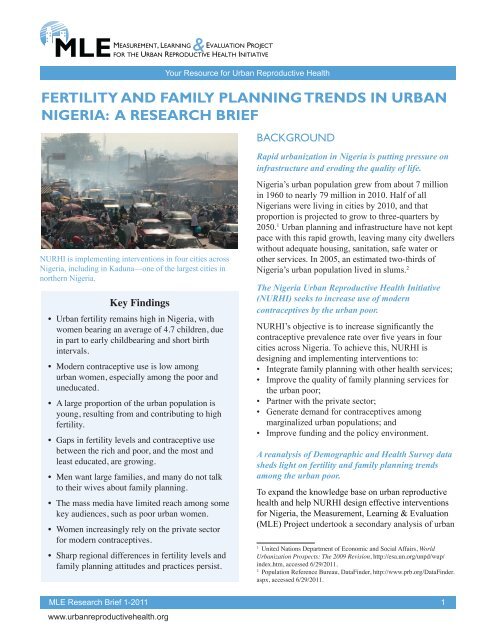
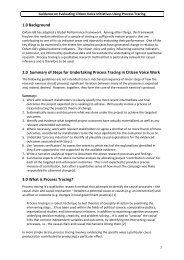
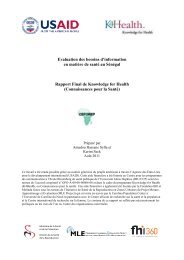





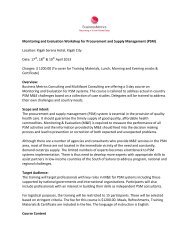

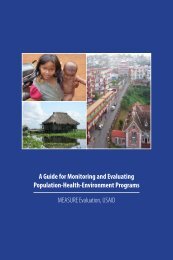

![questionnaire no: [__|__|__|__|__|__|__|__|__] - Measurement ...](https://img.yumpu.com/22729956/1/184x260/questionnaire-no-measurement-.jpg?quality=85)
![questionnaire serial no:[__|__|__|__] - Your Resource for Urban ...](https://img.yumpu.com/10870216/1/184x260/questionnaire-serial-no-your-resource-for-urban-.jpg?quality=85)